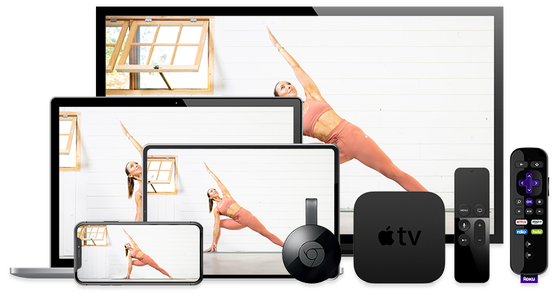Yoga for Beginners

Setup Your At-Home Yoga Practice
First thing first: you don’t need a ton of space. If you can roll out a mat and extend your arms, you can practice yoga asana. The area at the foot of your bed might be a readymade spot or you might move the coffee table, and voila—your Tadasana calls. If privacy is important to you, a home office or guest room where you can shut the door for the duration of class might help you—and your family—honor your practice. Finally, consider dedicating your space to make it special. A flower, crystal, meaningful image, or meditation beads can all help mark the space as sacred.
Equipment and Props
Choosing a Yoga Mat
Yoga mats run the gamut from bargain basement to deluxe models. Your choice is a matter of personal preference, but here are the three things to keep in mind:
Material: The cheapest entry-level mats are made from PVC and widely available, but if an eco-friendly option is important to you, seek out mats made from rubber, foam, cotton, or jute.
Thickness: Yoga mats typically come in one of three thicknesses. The most common is the 1/8" mat, which offers a combination of cushion and portability. Mats that are 1/16” are great for travel but can be hard for sensitive knees in kneeling poses. Mats that are 1/4" offer the most comfort but come with a price tag on the higher end of the spectrum; they’re also bigger and heavier to haul around.
Stickiness: A slippery yoga mat is about as good as running sneakers with holes in them. PVC and foam mats have the most stickiness, but only when clean and dry. If your hands and feet get sweaty or you love a hot yoga class, the natural texture of cotton and jute can help create stickiness. Some people also lay a yoga towel over their mat to help stay put. Rubber has a moderate amount of stickiness.
Props and Other Equipment
Depending on what kind of yoga class you’re trying, the teacher may suggest additional props to support your practice. The main purpose of yoga props is to help the posture meet you rather than pushing yourself to perform the posture. Don’t worry if you don’t have these props handy right away. If you are going to a yoga studio, most likely the studio will provide them for you. If you're practicing at home, some props that might be helpful as you get started include:
- 2 Blocks made of foam or cork (or two large books)
- 1 Strap (a towel or belt could also do the trick)
- 1 Bolster (or firm couch cushion)
- 1 Blanket
If you can keep your mat and any props in the area you plan to practice, it can make getting started that much simpler. Grab a laptop or phone to stream your practice through Yoga Anytime or, if you'd like to practice yoga in front of the television, you can use a suggested streaming device.
The yogi diet
Staying on Track
You have everything ready to go. Now what? Our first goal is to show up, but you might be feeling overwhelmed about where and how to begin. Consider joining one of our challenges or courses to organize and focus your practice. Programs like our 30-Day Yoga Challenge, the Enjoy Yourself Summer Challenge, and Start Yoga are designed to help get you started on the right path, and what’s more, keep you on track. We suggest finding a teacher you love and practicing with them for a while. The strengthening trust between teacher and student will also make it easier to trust yourself. Be aware, too, of the changes in life off the mat. How do you feel after practice? Are you sleeping better? Do you have more patience during the day?
How to Stay Motivated
As with anything new, it can be really challenging to stay motivated and keep showing up to your practice. Take the time to sit down and identify why you want to try yoga. Do you want more calm in your everyday life? Fewer aches and pains? Greater flexibility? Pinpoint your purpose, as well as the underlying reason you'd like to practice yoga. Then create your vision. Once you establish your intention, the mind is more committed to sticking to your plan. You may be thinking: How often should I practice yoga? You know your body best, but as a general rule of thumb we recommend practicing 3-5 times per week, if only for 20 minutes each time. Most importantly, trust that you are progressing and learning, and your practice will take care of you.
When you don't practice...
Part of you wants to practice yoga, and part of you probably doesn't. It will become easier to practice regularly when it becomes clear just how much yoga improves your whole life. Still, there may be days you don’t make it to the mat because you’re sick, too busy, or just not in the mood. When that happens, resist the temptation to be hard on yourself or self-scold, which can be a common newbie mistake. Self-scolding taxes the nervous system, creates stress, and with enough practice, can become addictive. If you're finding it hard to fit a longer class into your day, try committing to a class that is 20 minutes or less. Research shows that shorter practices done more often can be even more effective than a long one. And remember: tomorrow’s another day.
Tips on finding the right path
At some point, you might wonder how to find a local class that’s right for you. If you have friends who practice yoga, tag along with them to a class. Chances are, if it’s right for the members of your tribe, it’ll appeal to you, too. If you can’t follow your friends, pick a class and studio that fits within your life—a nearby location and a class at a time that’s convenient for you. If that’s not yielding a good fit, ask for the teacher’s input. If you share what it is you’re looking for, they’ll be eager to help you find the right class. And keep an eye out for new student specials. These promotions offer unlimited classes for two-weeks or a month and can be a great way to try a lot of different classes without breaking the bank.
From Our Blog
Next
Yoga Anytime Membership Benefits

- 15-Day Free Trial
- Unlimited access to 3,100+ classes
- 150+ Yoga shows and challenges
- No ads
- New videos weekly
- Watch on all your favorite devices



